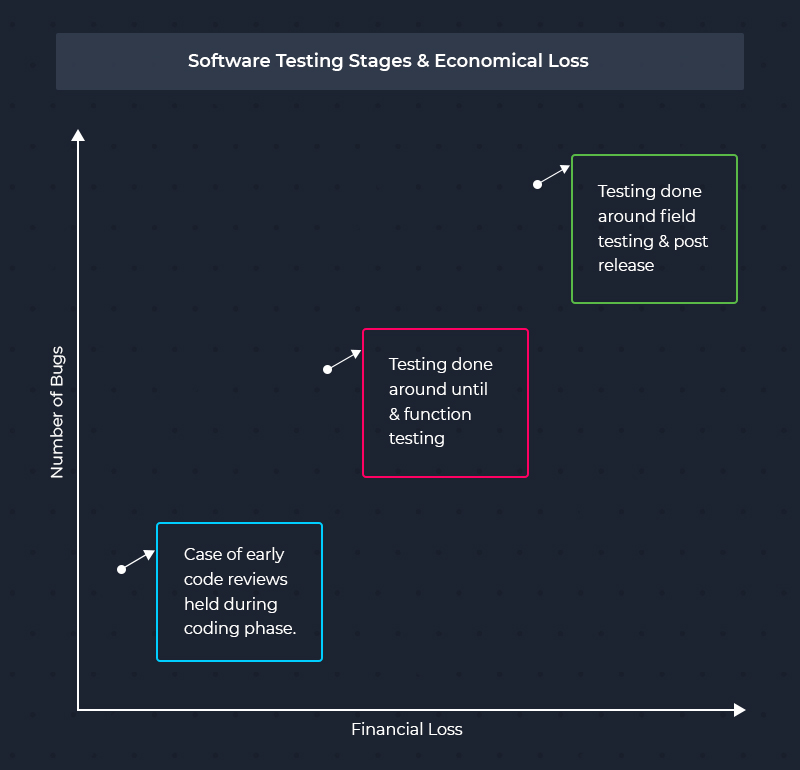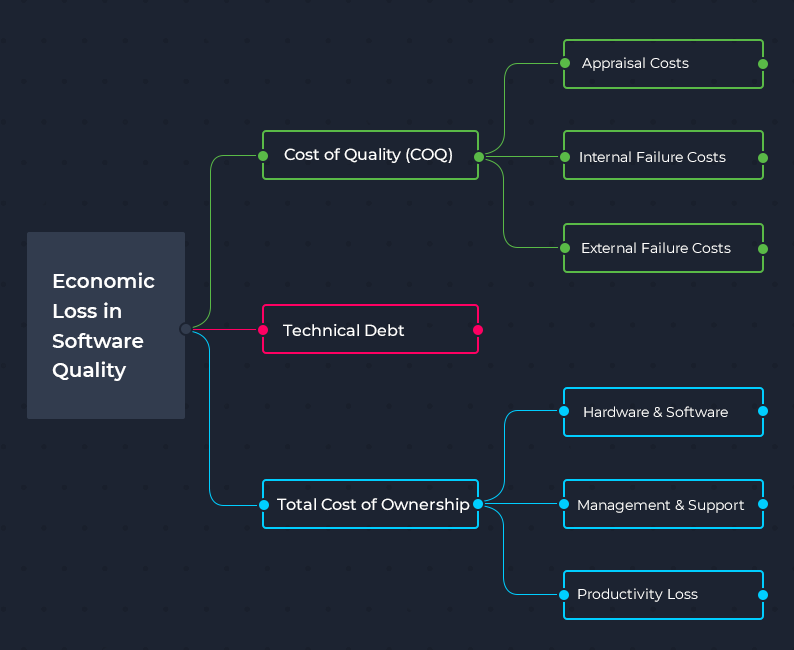Be it a startup or a large enterprise, it is important for businesses of all sizes to follow software development practices. Quality code not only contributes to the performance but also reduces the overall maintenance cost of the software in the long run. The extent of usage may depend on use case and organizational goals. In this blog, we compiled information to educate service seekers on different software coding standards and try to elaborate different factors to minimize economic loss in software development.
Table Of Content
Software Development Practices that Prevent Economic Loss
Project Documentation
Not exactly a software development coding practice but quite an important component of the lifecycle. Throughout the software development lifecycle, maintaining in-depth documentation pushes the project team to fulfill the exact business requirements. At the same time, documentation also enables the client to know the next step.
Different documents are created before and during the project. To understand the benefits as well as which documents are created, here is the complete list of documents associated with most software development projects:
1. Planning and Development Stage
Before the development stage, it is important to gather requirements from the client. Such information is compiled in a document called “high level resource document” or HRD in short. The HRD contains information about schedule, estimates, and overall requirements.
The documentation generated during the development stage may contain information elaborating sprint burndown charts, release burndown charts, and more. Other documents include API, source code, coding standards and working papers which are used to record a software engineer’s thoughts on solving a complex technical problem.
During this stage, emphasis is also placed on experience. Hence, the different aspects of experience are documented such as style guide, user personas, user story map, scenario map, and more. Developing such documentation is meaningful for a UX designer.
2. Quality Assurance and Quality Control Stage
The quality assurance (QA) and quality control (QC) stage may have a number of documentations. The documentation generally revolves around strategy, plan, specifications, checklists, and more. Here is brief information about different documents in QA and QC.
It is important for product managers to understand what the desired quality standards are. The quality management plan is one such document that elaborates how desired standards are to be achieved. The document also contains information on the testing activity schedule. While this document contain a high level view of testing activity, detailed explanation is given in:
- Strategy Document – The strategy document contains information on team structure and resource requirements required to conduct testing.
- Plan Document – Contains information on features to be tested, methods, timeframe, and roles.
- Case Specification Document – Information on each feature or functionality that is to be tested.
- Checklist Document – Information on tests that were successfully completed or failed.
We understand that meeting due dates to deliver projects is inevitable and important as well. Therefore, as an additional safeguard for our clients, we provide one important value with our software development service. The one year free technical support, which starts from the day of project delivery, is helpful for our clients if a bug is found.
3. Final Release
When a software is developed, there are different user types that may use its features. The two common user types are the end user and system administrator or admin in short. Before the final release, documentation for end users and admin can be created.
There is no one size fits all solution in the case of user documentation. For example, in certain cases where users have to be guided step by step, either a quick start guide or screencast video series can be created. Other educational resources include a section on frequently answered questions (FAQs) and support portal.
The common responsibilities of an admin includes installation, troubleshooting, configuration, maintenance, and more. In the case of admin, two documents can be created such as system administrator guide and features list also known as functional description guide. The features list contains information on functionalities of the software.
Creation of documentation is an essential step. We suggest that in case of small projects, certain documents can be avoided to reduce the project cost. On the other hand, for large projects, there should be proper documentation. The creation of documents also depends on the methodology being used. For example, in agile, documentation is given second priority.
Early Code Review
In most cases, a software product goes through different testing stages after coding – unit, functional, field, and post-release. To understand the benefits of early code review, consider the following use cases:

Use Case 1 – Most testing time is spent during coding
Out of the three use cases, the case of early code review results in the least number of bugs or errors. Hence, little or no financial loss for the client as well as software development service provider.
Use Case 2 – Most testing time is spent equally during unit, function, and field testing
The second use case can be considered as the case where bugs and errors are found but not in a significant quantity. Furthermore, the financial loss incurred due to bugs is slightly higher than the previous use case.
Use Case 3 – Most testing time is spent around field testing and post-release
This can easily be considered as the worst case where there are a maximum number of bugs and errors. Due to such a significant number of bugs, the financial loss is much greater than previous use cases.
Software Testing
The art of testing varies from one software development service provider to another. The general flow throughout the testing process is – creation of test strategy, the execution phase, and reporting or analysis phase to check completed tests along with reasons behind failed tests.
1. Essential Testing Concepts According to IEEE Standard for Software and System Test Documentation
Integrity levels
Distribution of different aspects of software testing according to importance.
Minimum number of required testing tasks
Once the integrity levels are established, the QA team has to define the minimum number of testing tasks for each integrity level. There can be an additional set of tasks that is purpose-driven and tailored to meet additional requirements.
Intensity and rigor
To understand this concept, one has to know what intensity and rigor is in the software testing. Intensity in the software testing process can be defined as greater scope of testing across all operating conditions. Rigor is the use of more formal techniques as well as recording methods. Ideally, high integrity levels require more intensity and rigor.
Minimum criteria to pass tests
Each aspect of the software development life cycle should be managed and executed in a measurable way. Similarly, pass criterias can be defined for each testing task. The recommended practice is to define the minimum criteria required as well as well-defined outputs.
System tests
While features and functionalities may take maximum time during the testing phase, it is equally important to address system-level issues.
Test Documentation
It is important to identify the topics that are to be covered in the documentation.
2. Two Basic Components of Testing Phase
Creation of strategy phase
The software testing strategy can either be preventative or reactive. In simple terms, preventative testing strategy is one where test cases are designed before the software is developed. In the reactive testing strategy, test cases are designed after the software is developed. A purpose-driven strategy addresses multiple aspects associated with testing. Few such aspects include:
- Which steps should be taken to execute the testing?
- The selected steps should be well described.
- Identify the efforts, time, and resources required.
Execution of testing phase
The testing phase involves development of test cases, setup of development environment, the actual execution, and test cycle closure. It is critical for the quality assurance (QA) team members to identify all the scenarios (test cases) and generate relevant test data that can be used during the testing phase. At the end of the testing phase, the test closure cycle is initiated which contains information on coverage, quality, cost, time, and more.
FATbit holds expertise in agile software development practices to add value for the client. Using agile methodology, we have delivered custom web and mobile apps in frameworks and libraries like Laravel, Node.js, and more. From live chat software, capable of handling thousands of requests every day to enterprise-grade software solutions that adds value for businesses operating within B2B, we are capable of handling each use case.
Why follow software development coding standards? Is it expensive?
There are different benefits of following software development coding standards for service seekers and providers. The main aspect which connects seekers with providers is cost. According to a survey conducted by Capers Jones, cheap development services often prove to be expensive.
To elaborate this further, take an example where a programmer with less experience starts working to develop a SaaS-based software solution for a client. The programmer makes a mistake which doesn’t surface till the testing phase. Important things to note are:
- Bug removal may require many development hours thus delaying the project.
- The delay may impact time to market (TTM) resulting in loss of competitive advantage.
- Initial users of the product may go through a bad experience due to bugs.
- Poor user experience (UX) may impact brand value in the long run.
The above-mentioned list of points can be endless. Poor coding standards directly result in loss of business value. There are many ways in which loss can be prevented for the client or service seeker as well as for the service provider.
Terms Explaining Economic Loss in Software Quality
The standards can be explained through different software development practices. Many practices are commonly followed by service providers but few quality-centric practices may require additional effort and increase the overall budget. Before sharing common practices that may help lower the cost in a software development project, it is important to understand what loss is. Here are three terms:

Technical Debt
Technical debt primarily occurs when emphasis is on quick delivery of the software solution. In doing so, many bad practices can be followed unknowingly. Few such practices are:
- Not spending enough time to remove bugs.
- Using legacy code that may become obsolete soon.
- Not properly commenting or documenting.
While the service provider may have delivered the solution, the client may have to spend more on maintenance as well as enhancements. Ideally, bugs often surface within days or weeks of usage in case of a new product.
Cost of Quality (COQ)
The cost of quality emphasizes potential savings through process improvements. Few key components of COQ are costs associated with appraisal, internal failures, and external failures. Here is a brief explanation of the three cost components.
Appraisal Costs
Following good coding practices is not the only factor to achieve quality. When building any software that may require a few months of development time, measuring and monitoring activities are required as well to ensure that delivered product meets industry standard. Here is an activity-level breakdown that can be considered under appraisal cost:
- Consistent involvement of an experienced business analyst to verify the software development practices are put in the right direction as per the expectation of the client.
- Code audits (and re-audits) conducted by an experienced programmer to identify potential bugs that may surface at a later stage.
- Quality of third-party applications and their APIs that are to be integrated with the software solution being developed.
Internal Failure Costs
During the testing phase, most bugs are removed. However, there are times when a flaw is found within the software design itself. The cost incurred to correct such mistakes that happen before the deployment of the software solution is the internal failure cost. Here are few sub-activities that can be covered under internal failure costs:
- Delay in software deployment due to bugs or errors.
- Major modifications required due to fault in software design.
- Time exhausted in analysis of errors or bugs in the software.
External Failure Costs
When bugs and errors are found in a software solution after it has been delivered to the client, the incurring cost to remove such bugs is termed as external failure cost. Few sub-activities associated with external failure cost are:
- Time spent in communication between client and customer service team.
- Time exhausted in understanding the bug as well as removing the bug.
Total Cost of Ownership
When a client invests in a software, the actual cost of using the software might be more than developing one. Different resources are required to use software throughout its lifecycle. Here are few key areas that are an essential component of total cost of ownership:
Hardware and Software Acquisition
Hardware as well as software are required from the client’s end to execute the deployed software. Consider an example where a client recently purchased an online marketplace solution. Deploying it will require a web hosting, domain name, SSL certificate, and more.
Management and Support
To use any software, user training is required. There is a cost associated with backup and recovery, server downtime, insurance, and more. Another major chunk of cost may arise from software maintenance as technologies keep updating with new versions to maintain security and add features.
Productivity Loss
While user training is essential to use a new software, it is equally important to acknowledge the productivity loss during the period of training. Even after the training has been completed, the person may still take more time to complete an operation.
Benefits of following coding standards in software development practice
The main purpose of following software coding standards is to improve security, algorithmic efficiency, create efficient data structures, code reusability, and more. By partnering with a software development company which follows coding standards could help you control the software development cost and provide a bug-free user experience to the end user.
1. Improved Security
Coding standards play a vital role in adding extra checks for hackers who try to steal information from a web or mobile app. Security of any web or mobile application is also linked with using the latest version of the programming language being used. Ideally, when a new version of a programming language or framework is released, few old functions are deprecated. Hence, it is better to consider current stable versions of programming languages or frameworks and is an important aspect of software coding standards.
2. Supports Change
Custom software solutions are required to be modified at different times due to changes in the business model or government regulations. For example – When the government of India introduced GST in tax, many retailers, ecommerce marketplace, custom SaaS solution providers, and more had to modify their tax calculation feature. Such changes were possible when the code was clearly written and well documented.
3. Better Quality
Code auditing is an important activity where experienced programmers audit the code to identify scope of improvement in quality. The outcome of this activity is removal of bugs or errors.
4. Compliance
Software development coding standards pushes the programmers to use universal syntax. Doing so, helps in improving the readability and reducing the code complexity. If you have an in-house team or plan to hire a new web or mobile app development team, then new team members can easily navigate through the code and start developing.
5. Maintenance
When a custom software is deployed, there are chances you may want to modify it after a few weeks or months. To do so, the programmer has to go through each feature and understand the code. A custom software developed by following coding standards may have comments within the code to assist a new developer. Such practices improve the time taken by the developer to understand the code which compliments efficient software maintenance.
Conclusion
No matter which framework or language you’re using in your software development project, implementing coding standards could help you minimize the economic loss. The coding practices help in generating ethical and flexible code sufficient enough to meet all performance criteria.




